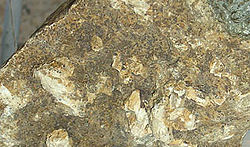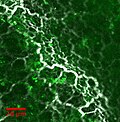Tissue engineering is a biomedical engineering discipline that uses a combination of cells, engineering, materials methods, and suitable biochemical and...
115 KB (14,048 words) - 02:57, 4 May 2025
Muscle tissue engineering is a subset of the general field of tissue engineering, which studies the combined use of cells and scaffolds to design therapeutic...
39 KB (4,760 words) - 22:46, 22 May 2025
Amylopectin (section Tissue engineering)
Sander C.G. (1 February 2022). "The Use of Fibers in Bone Tissue Engineering". Tissue Engineering Part B: Reviews. 28 (1): 141–159. doi:10.1089/ten.TEB.2020...
33 KB (3,879 words) - 22:44, 29 May 2025
biological tissue, enabling higher resolution imaging and improved accuracy in procedures such as laser surgery and retinal imaging. Tissue engineering, like...
61 KB (6,334 words) - 17:10, 13 June 2025
Neural tissue engineering is a specific sub-field of tissue engineering. Neural tissue engineering is primarily a search for strategies to eliminate inflammation...
37 KB (4,696 words) - 11:23, 24 January 2025
Tissue engineering of oral mucosa combines cells, materials and engineering to produce a three-dimensional reconstruction of oral mucosa. It is meant...
17 KB (2,149 words) - 21:45, 29 May 2025
Biomaterial (redirect from Biomaterials Engineering)
replace a tissue function of the body) or a diagnostic one. The corresponding field of study, called biomaterials science or biomaterials engineering, is about...
52 KB (5,931 words) - 20:59, 26 April 2025
Nanofabrics (section Tissue Engineering)
textile manufacturing and areas of medicine such as drug delivery and tissue engineering. A fiber that has a width of less than 1000 nanometers (1000 nm or...
15 KB (1,538 words) - 20:55, 30 October 2023
and reoperation. Thus, in situ (in its original position or place) tissue engineering of heart valves serves as a novel approach that explores the use creating...
29 KB (3,690 words) - 18:53, 4 September 2023
problems at the interface of living neural tissue and non-living constructs. The field of neural engineering draws on the fields of computational neuroscience...
41 KB (4,964 words) - 03:43, 14 April 2025
Biomedical engineering: application of engineering principles and design concepts to medicine and biology for healthcare purposes. Tissue engineering Neural...
16 KB (1,621 words) - 15:37, 26 May 2025
Amniotic stem cells (section Foetal tissue engineering)
stem cells from foetal tissue. A small amount of amniotic fluid provides a large enough quantity of cells for the tissue engineering process and could help...
26 KB (3,054 words) - 20:23, 5 December 2024
which includes organ engineering, tissue engineering, protein engineering, and genetic engineering. The field of cellular engineering is gaining more traction...
15 KB (1,658 words) - 22:33, 22 May 2025
soft tissues. This phenomenon was discovered in 1912, and the terminology was introduced in 1945, but it is with the development of tissue engineering[when...
15 KB (1,759 words) - 20:03, 7 December 2024
Arginylglycylaspartic acid (section Tissue engineering)
tumor-targeted nanoparticles. Further, RGD is widely used in tissue engineering to promote tissue regeneration. Conventional drug delivery methods, such as...
37 KB (3,744 words) - 13:30, 22 May 2025
Artificial ligament (section Tissue engineering)
ligament has been utilized extensively in clinical applications. Tissue engineering is a growing area of research which aims to regenerate and restore...
20 KB (2,310 words) - 20:01, 29 May 2025
Soft tissue connects and surrounds or supports internal organs and bones, and includes muscle, tendons, ligaments, fat, fibrous tissue, lymph and blood...
17 KB (2,106 words) - 14:23, 26 May 2025
tissue is one of the four primary types of animal tissue, a group of cells that are similar in structure, along with epithelial tissue, muscle tissue...
18 KB (1,633 words) - 23:57, 28 May 2025
Tissue clearing refers to a group of chemical techniques used to turn tissues transparent. By turning tissues transparent to certain wavelengths of light...
19 KB (2,064 words) - 03:41, 4 January 2025
Charles Vacanti (section Tissue engineering)
Charles Alfred "Chuck" Vacanti (born 1950) is a researcher in tissue engineering and stem cells and the Vandam/Covino Professor of Anesthesiology, Emeritus...
24 KB (2,346 words) - 00:34, 22 May 2025
Polymer nanocomposite (section Tissue engineering)
infinitively long. For a broad range of applications including catalysis, tissue engineering, and surface modification of implants this infinite length is an advantage...
23 KB (3,083 words) - 03:56, 25 May 2025
Nano-scaffold (section Tissue engineering)
as in vitro cell and tissue substrates. This early use of electrospun fibrous lattices for cell culture and tissue engineering showed that various cell...
29 KB (3,856 words) - 17:40, 26 May 2025
Embryonic stem cell (section Tissue engineering)
transplantation or tissue engineering." In tissue engineering, the use of stem cells are known to be of importance. In order to successfully engineer a tissue, the...
73 KB (8,675 words) - 21:35, 22 May 2025
Nanocomposite hydrogels (section Tissue engineering)
as a tissue replacement. Nanocomposite hydrogels incorporated with polymeric nanoparticles are tailored for drug delivery and tissue engineering. The...
18 KB (2,212 words) - 09:42, 22 October 2024
Melt electrospinning (section Tissue Engineering)
fibrous structures from polymer melts for applications that include tissue engineering, textiles and filtration. In general, electrospinning can be performed...
12 KB (1,589 words) - 22:14, 2 June 2025
biomedical applications including wound healing, drug delivery and tissue engineering. Due to its specific intermolecular hydrogen bonding network, dissolving...
27 KB (2,789 words) - 22:35, 22 May 2025
Tissue culture is the growth of tissues or cells in an artificial medium separate from the parent organism. This technique is also called micropropagation...
14 KB (1,711 words) - 16:32, 25 May 2025
chemical similarity to hard tissue. In the future, there are possibilities for using nano-hydroxyapatite for tissue engineering and repair. The main and...
38 KB (4,034 words) - 06:44, 2 June 2025
Breast augmentation (section Tissue engineering)
autologous fat-grafts Khouri RK, Cardoso E, Marchi A, Rigotti G. (2010) Tissue Engineering a Breast Mound by External expansion & Autologous fat Grafting Archived...
124 KB (14,393 words) - 20:11, 29 May 2025
"Use of Multiphoton Microscopy for Tissue Engineering Applications". Imaging in Cellular and Tissue Engineering, 1st edition. CRC Taylor&Francis. ISBN 9780367445867...
48 KB (5,024 words) - 00:48, 31 May 2025
















